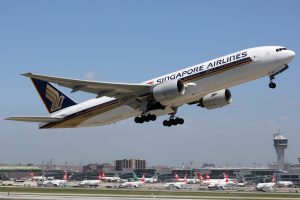The financial year that ended in March 2023 was a very good year for Singapore Airlines (SIA). The national carrier together with its subsidiaries recorded after-tax income of SG $2.16 billion ($1.6 billion). They have announced that some of these earnings will be disbursed to employees via a profit-sharing plan equal to around eight months of salary. It’s a far cry from where the company was in the 2020/2021 fiscal year, when cash from operations was negative SG $3.3 billion.
It seems safe to say that with the world and its airports open for business again, Singapore Airlines has recovered strongly. In fact, the company had more shareholder equity in March 2023 than it had in March 2019, before the COVID-19 pandemic. Other flag carriers around the region, such as Thai Airways and Indonesia’s Garuda, required big rescue packages and debt restructurings just to stay solvent. Their earnings are looking healthier these days, but both airlines currently still have negative equity (their liabilities exceed their assets).
One reason profits are up is that last year ticket prices were up. As global travel surged back to life in 2022, the same thing happened to airlines as happened to other industries: high demand and limited supply created high prices. With people coming out of lockdowns, demand for travel was extremely high, but short-term supply remained limited as routes were re-opened gradually and planes and crews had to be readied to go back into service.
When demand outpaces supply like that, prices tend to go up. Now that international travel is getting back to a more typical equilibrium (more planes from more carriers flying to more places) I wouldn’t expect operating margins to be as high going forward. But pricing aside, there is another reason why Singapore Airlines weathered the pandemic better than many: it owns most of its airplanes.
Airplanes are expensive. For carriers that operate hundreds of planes, purchasing them outright requires a big outlay of capital, potentially billions of dollars. Many carriers opt instead to lease much of their fleet. This asset-light approach can work as long as the airline has steady cashflow to make the lease payments (and they don’t sign bloated and overly expensive leases, something Garuda is alleged to have done).
Both Garuda and Thai Airways were heavily reliant on leased aircraft before the pandemic. In 2020, for instance, Thai Airways had about $4 billion worth of lease liabilities on their balance sheet, equal to 59 percent of total assets. In 2020, Garuda had $4.5 billion in long-term lease liabilities, equal to around 42 percent of total assets. Garuda’s fleet consisted of 189 leased aircraft in 2019.
In March 2019, Singapore Airlines and its subsidiaries had a fleet of 202 aircraft. Only 66 were on operating leases, with the other 136 owned by the airline. When the pandemic hit, Singapore Airlines faced the same cash crunch as everyone else. But because it owned most of its income-generating assets, it didn’t have the added problem of owing billions of dollars to outside parties for aircraft with nowhere to fly. This meant the airline could focus on raising cash to buffer against short-term operating losses, but it was never in danger of insolvency.
The shock of the pandemic provided carriers like Garuda and Thai Airways an opportunity to reduce some of their lease liabilities by returning some aircraft and lowering payments on others. Their balance sheets look better now. Thai Airway’s negative equity shrunk from $4.1 billion in 2020 to $2 billion last year. Garuda’s negative equity went from $6.1 billion in 2021 to $1.5 billion in 2022. In both cases liabilities still exceed assets, but the deficit is narrowing. Had there been no sudden stop in international travel, it would have been much harder to renegotiate these liabilities with creditors. So, in some ways, the recent down years put them on a more sustainable long-term path.
But this experience underlines a key vulnerability in the way many modern airlines are run and highlights the trade-offs involved in leasing rather than owning. The big benefit to owning, as Singapore Airlines shows, is that the assets from which you generate income belong to you. When the pandemic hit, every airline in the world had an operating cash shortfall. But for airlines with big lease obligations, it meant that not only could they not cover all their operating costs but also, they could no longer pay their lessors. And in the business world that can be a much worse problem to have.

































